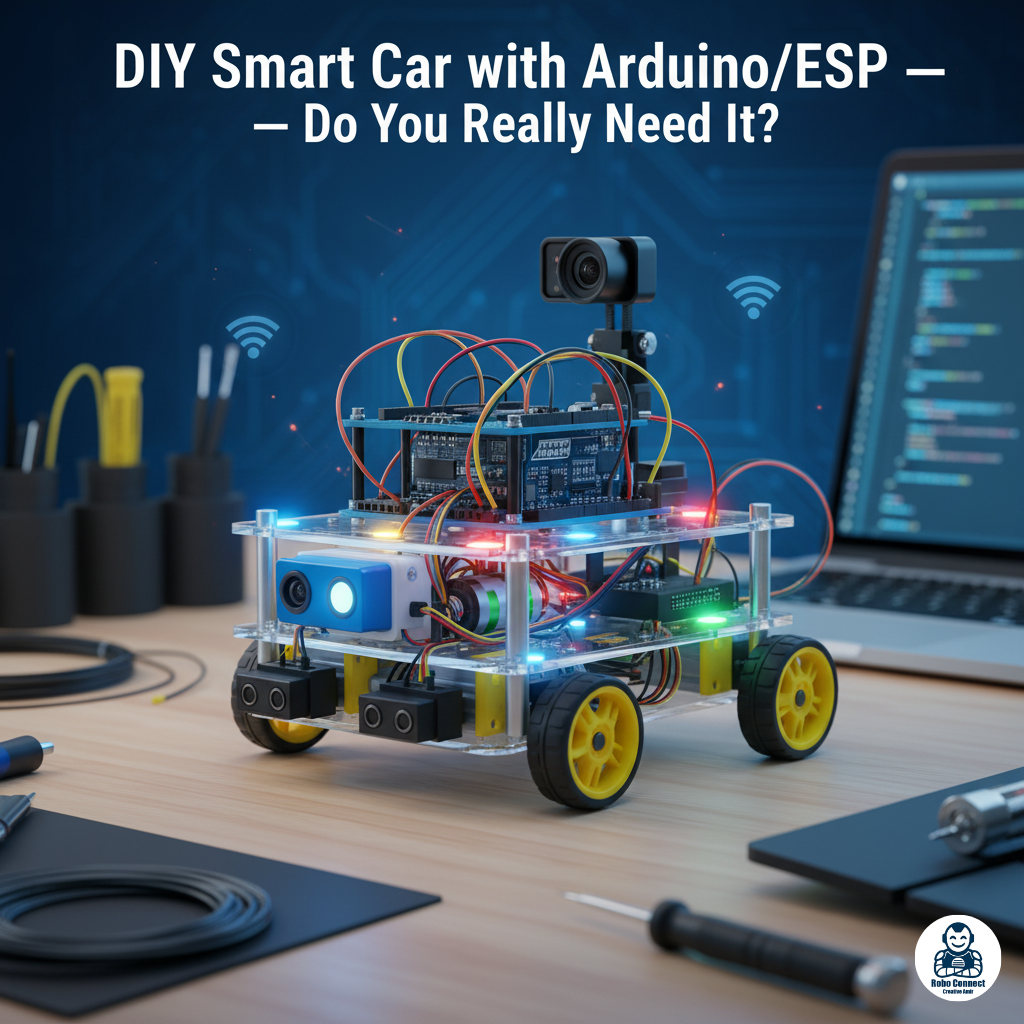Introduction
Smart cars aren’t only Tesla or fancy self‑driving vehicles. At the hobby level, a DIY Smart Car means a programmable robot car built with a microcontroller (Arduino) or a Wi‑Fi/Bluetooth board (ESP8266/ESP32).
The question comes up often: “Should I really build one? Is it necessary, or just a gimmick?”
Let’s explore why DIY Smart Cars are useful, what they teach, and when you should (and shouldn’t) make one.
What is a DIY Smart Car?
A basic robotics kit on wheels, made of:
- Chassis + DC Motors (movement),
- Motor Driver (L298N / L293D) (controls motors),
- Arduino (the brain, usually for simple control), or
- ESP8266/ESP32 (brain + built‑in Wi‑Fi/Bluetooth, for smart wireless functions),
- Sensors: IR for line following, Ultrasonic for obstacle avoidance, Bluetooth/Wi‑Fi modules for remote control.
Result: A little robot car that can be controlled by phone, follow lines, avoid obstacles, or even upload data to the cloud.
Why Build a Smart Car Project? (Is It “Need”)
- Learning Purpose (Yes it’s needed)
- Teaches how to combine motors, sensors, coding, electronics.
- A practical, fun way to understand robotics principles.
- Foundation of Bigger Projects
- A smart car is basically a mini autonomous vehicle. Once you get this working → you can branch into drones, robots, and IoT vehicles.
- ESP vs Arduino Choice
- Arduino Uno is simple and beginner‑friendly, great for offline tasks (line following, obstacle avoidance).
- ESP8266 / ESP32 has Wi‑Fi/Bluetooth built in → lets you control your car over phone apps, via web dashboards, or even integrate with IoT cloud.
- If your goal = learning advanced IoT, go ESP. If your goal = pure electronics basics, Arduino is enough.
- Innovation & Experiments
- Add a camera → ESP32 Cam = low‑cost surveillance car.
- Add sensors → Gas detection car, temperature logging rover.
- Add AI → Raspberry Pi + camera = vision‑based autonomous car.
- Is It Necessary For Everyone?
- Yes if: you’re into electronics/robotics learning, STEM education, student projects, DIY fun.
- Not really if: you just want a remote‑controlled toy car (cheaper to buy one!).
What You Will Learn From Building One
- Circuit wiring (motors, drivers, boards).
- Coding for robots (Arduino IDE, C++ or MicroPython).
- Motor control (PWM speed + direction).
- Sensor integration (IR → line following, Ultrasonic → obstacle avoidance).
- Wireless communication (Bluetooth, Wi‑Fi).
These are core robotics + IoT skills used everywhere, from smart cars to drones.
Example Features of DIY Smart Car
- Obstacle Avoidance Mode → Avoid collisions using ultrasonic sensor.
- Line Following Mode → IR sensors help robot follow a track.
- Phone Control Mode → Connect via Bluetooth/Wi‑Fi from Android app.
- IoT Mode → ESP board sends live data to Google Sheets or Thingspeak.
Conclusion: Do You Need to Build One?
If you’re a beginner enthusiast, student, or educator — Yes, you should!
A DIY Smart Car project is one of the best hands‑on ways to learn robotics, IoT, and AI fundamentals.
If all you want is a toy to play with — No, just buy a ready‑made RC car.
But for anyone serious about learning electronics, programming, or robotics as a career or hobby — a DIY Smart Car with Arduino/ESP is a must‑do milestone project.

